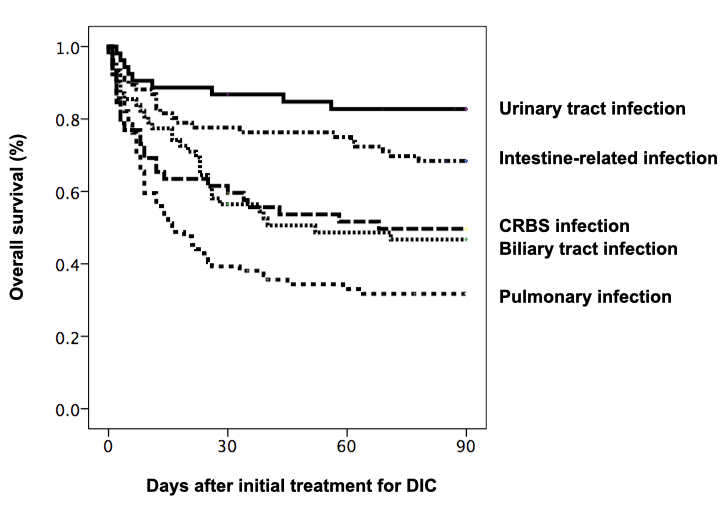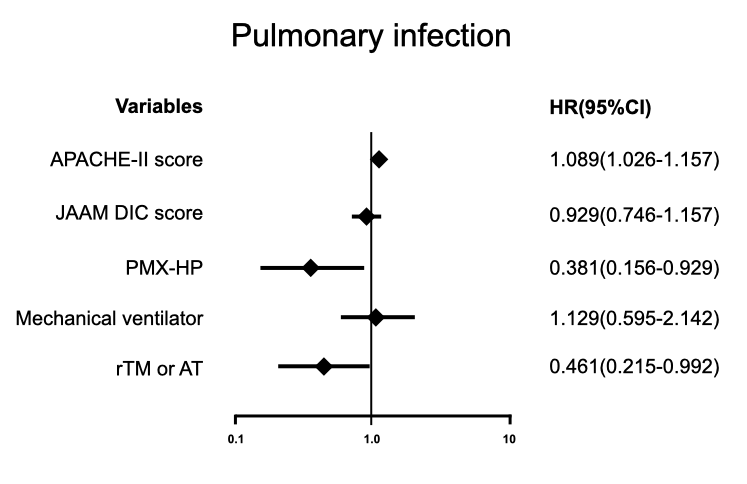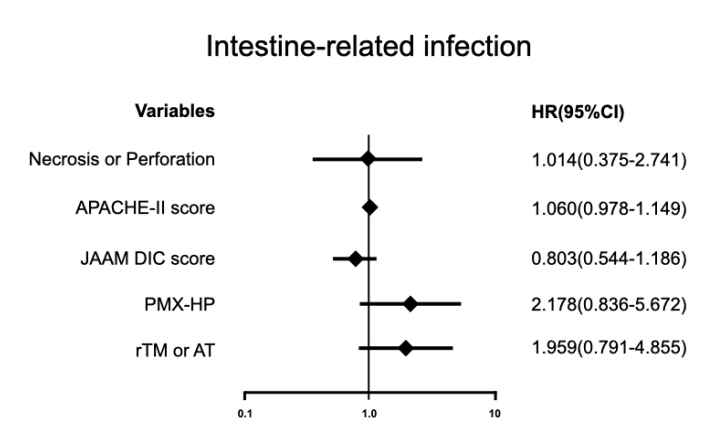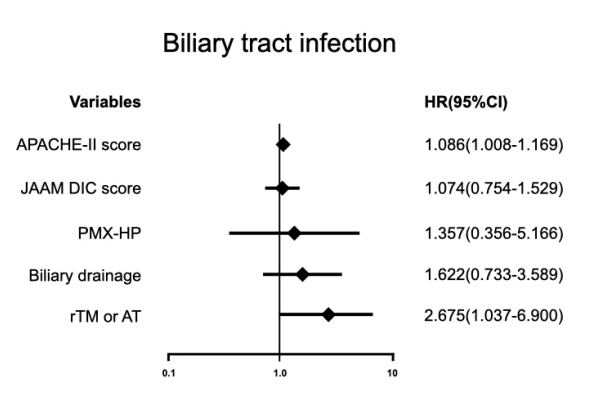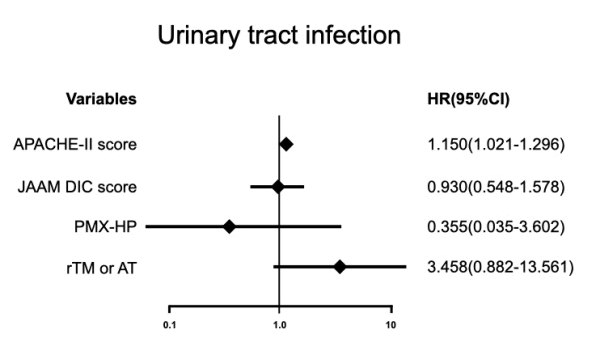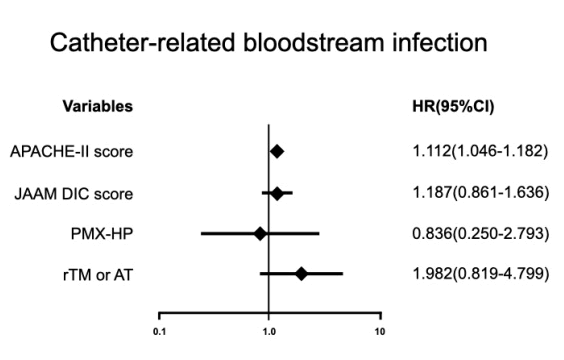Makoto Kobayashi1*, Ryosuke Asakura2, Yoshimatsu Ehama2 and Suguru Hirayama2
1 Intensive Care Unit, Hakodate Goryoukaku Hospital, 38-3 Goryoukaku-cho, Hakodate, Hokkaido, Japan
2 Department of Emergency Medicine, Hakodate Goryoukaku Hospital, 38-3 Goryoukaku-cho, Hakodate, Hokkaido, Japan
*Corresponding Author:
- Makoto Kobayashi
Director of Intensive Care Unit, Hakodate Goryoukaku Hospital, 38-3 Goryoukaku-cho, Hakodate,
Hokkaido 040-8511, Japan
Tel: +81-138-51-2295
Ext: 5798
Fax: +81-138-56-2696
E-mail: koba86gg@gmail.com
Received date: 01 March, 2021; Accepted date: 15 March, 2021; Published date: 22 March, 2021.
Citation: Kobayashi M, Asakura R, Ehama Y, Hirayama S (2021) Impact of Anticoagulant Therapy on Mortality for Sepsis- Associated Disseminated
Intravascular Coagulation Depending on the Source of Infection J Intensive & Crit Care Vol.7 No. 3:37
Introduction: Sepsis can be caused by various infections,
and coexistence of Disseminated Intravascular Coagulation
(DIC) exacerbates mortality. Reportedly, anticoagulant
therapy could be associated with a survival benefit in
patients witshe psis-associated DICT.h e use of
Antithrombin (AT) replacement therapy and Recombinant
Thrombomodulin (RTM) preparations are typically applied
as part of anticoagulant therapy, but which therapeutic
modality should be prioritized is unclear.
Objectives: Thsist udy aimed to clarify whether
anticoagulant therapies affect mortality depending on the
source of infection and identify the suitable treatment, AT
or RTM, based on the source of infection.
Patients and Methods: Thiss ingle-center retrospective
cohort study involved 297 patients with sepsis-associated
DIC treated by either AT replacement therapy or RTM
preparation. Participants ewre categorized tino the
following five groups according to the source of infection:
pulmonary, intestine-related, biliary tract, urinary tract, and
catheter-related bloodstream infection groups. To assess
the clinical efficacy of AT or RTM depending on the source
of infection, 90-day mortality was examined using a Cox
proportional hazard model.
Results: AT replacement therapy reduced the mortality in
pulmonary infection (Haazrd Ratio (HR), 0.461; 95%
Confidence Interval (CI), 0.215–0.992; P=0.048), and RTM
preparation did in biliary tract infection (HR, 2.675; 95% CI,
1.037–6.900; P=0.042).
Conclusion: The impact of anticoagulant therapies showed
different influence depending on the source of infection,
and we suggest that it is necessary to properly use of AT
replacement therapy and RTM preparations.
Keywords: Thrombomodulin; Antithrombin; Polymyxin-
B Hemoperfusion; Pulmonary infection; Biliary tract
infection.
Introduction
Sepsis can be caused by various infections, and the related
mortality rates are substantially higher in patients with
Disseminated Intravascular Coagulation (DIC) [1]. Regarding
benefit profile of anticoagulant therapy in sepsis, a nationwide
multicenter registry in Japan [2] was analyzed and reported that
aggressive therapy of DIC were important for improving patient
outcomes in addition to treating the underlying disease. For
management of DIC, Antithrombin (AT) replacement therapy
and Recombinant Thrombomodulin (RTM) preparations were
suggested by the Japanese Clinical Practice Guidelines for
Management of Sepsis and Septic Shock 2016 (J-SSCG 2016) [3].
However, international guidelines for management of sepsis in
2016 [4] recommended against the use of AT and provided no
recommendation regarding the use of RTM for treatment of
sepsis and sepsis shock. Cochrane Database Systemic Review in
2016 [5] reported that there was insufficient evidence to
support AT substitution in any category of critically ill
participants, and they did not find a statistically significant effect
of AT including the subset of patients with sepsis and DIC. The
SCARLET randomized clinical trial examined effect of RTM on
mortality in patients with sepsis-associated coagulopathy
concluded that administration of RTM, compared with placebo,
did not significantly reduce mortality [6]. At this time, there are
no clear institutional guidelines as to which therapeutics should
be prioritized.
Factors that affect the prognosis include not only the severity
of the disease but also the selection of appropriate treatments
and the use of effective therapeutic drugs. It also seems that the
mechanism of progression of disease or onset of DIC differs
depending on the source of infection and implies the necessity
of considering the specific characteristics in deciding treatment
policies. This indicates that, if the therapeutic effect of drugs is
discussed, a comparison should be made by source of infection.
Therefore, we hypothesized that anticoagulant therapies may
differently impact patient mortality according to different
sources of infection. This study also focused on identifying which
treatment, AT replacement therapy or RTM preparation, was
suitable for which source of infection.
Patients and Methods
Study design
This was a retrospective cohort study of patients with sepsisassociated
DIC who were admitted to Hakodate Goryoukaku
Hospital during the period from May 2008 to December 2019.
Patients were excluded if they were suffered from Child–Pugh C
hepatic cirrhosis, hematologic diseases such as leukemia, and
end-stage cancer. Our study protocol was approved by the local
ethics committee in our hospital (No.2020-049), and informed
consent was waived because of this study’s retrospective design.
Definitions
Sepsis was diagnosed based on the Sepsis-3 criteria [7], and
DIC was defined as a total score of ≥ 4 according to the Japanese
Association for Acute Medicine (JAAM) DIC scoring system [8].
The Acute Physiology and Chronic Health Evaluation II (APACHEII)
[9] are used as tools to objectively assess patient clinical
severity. Baseline data were collected from electronic medical
records, and were calculated to confirm their diagnosis at the
time when DIC treatment was planned. All patients were
followed-up for 90 days after a diagnosis of sepsis with DIC.
Data collection and management
Participants were categorized into the following five groups
according to the source of infection: Pulmonary, Intestinerelated,
Biliary tract, Urinary Tract, and Catheter-Related
Bloodstream (CRBS) infection groups.
The anticoagulant therapies for DIC available in our hospital
are limited to the use of AT replacement therapy or RTM
preparations. For AT replacement therapy, the supplementation
dose of AT was 1500 IU/day for 3 days; RTM was administrated
at a dose of 380 U/kg, but the dose was reduced to 130 U/kg in
patients with renal disorders. In this retrospective study, there
were no predefined protocols regarding the definite indications
for using AT replacement therapy or RTM preparation.
Therefore, these therapeutic modalities were administered at
the discretion of the attending physician.
In our series, all patients in intestine-related infection group
underwent emergent surgical procedures, and sepsis-associated
DIC occurred after surgery. In the biliary tract infection group, a
biliary drainage applied for a treatment of biliary obstruction.
Polymyxin B Hemoperfusion (PMX-HP) was indicated for patients
with septic shock unresponsive to standard fluid resuscitation
and the use of cardio-vascular agents; however, its enforcement
was left to the discretion of the attending physician.
Statistical analysis
Results are presented as mean ± standard deviation. Overall
survival time was defined as the time from DIC diagnosis to any
cause death. The Kaplan–Meier method was used to estimate
survival rates depending on the source of infection, and a
comparison was made using a log rank test. To assess the clinical
efficacy of AT replacement therapy or RTM preparation, 90-day
mortality was examined using a Cox proportional hazard model
with APACHE-II score, JAAM DIC score, and preparation of PMXHP
as common variables in each infection group. In the
intestine-related infection group, intestine damage could be
etiologically attributed to two variables, intestinal necrosis or
perforation, and these variables were added to the multivariate
analysis. Preparation of biliary drainage in biliary tract group and
the indication of mechanical ventilation to the patient in
pulmonary infection group were included as additional variables
in group analysis, respectively. Hazard ratios and 95%
confidence intervals were determined for these variables. In all
tests, P<0.05 was considered statistically significant. Statistical
analysis was performed using IBM SPSS Statistics for Macintosh,
Version 21.0. (Armonk, NY: IBM Corp.).
Results
Patient characteristics
In total, 297 consecutive patients who presented with sepsisassociated
DIC and simultaneously treated by either AT
replacement therapy or RTM preparation were assessed for
inclusion in the study. Enrolled patients were categorized based
on five sources of infection, and the characteristics are shown in Table 1. All patient in intestine-related infection group
underwent emergency surgery owing to the clinical diagnosis of
intestinal necrosis (n=23) or intestinal perforation (n=46). In
biliary tract infection group, biliary drainage was performed in
64% (36/55) patients. In pulmonary infection group, mechanical
ventilation was installed in 54% (42/76) patients.
| Variables |
Pulmonary infection |
Intestine-related infection |
Biliary tract infection |
Urinary tract infection |
CRBS infection |
| Patients, n |
76 |
69 |
55 |
52 |
45 |
| Age, mean (SD) |
74(12) |
74(10) |
78(11) |
74(11) |
69(13) |
| Sex (men/women), n |
46/30 |
40/29 |
27/28 |
15/37 |
22/23 |
| APACHE-II score, mean (SD) |
21(6.5) |
21(6.1) |
15(4.9) |
17(5.7) |
19(7.6) |
| JAAM DIC score, mean (SD) |
5.6(1.4) |
5.1(1.2) |
5.8(1.3) |
5.7(1.4) |
5.8(1.6) |
| Polymyxin B hemoperfusion, n (%) |
13(17) |
18(26) |
4(7) |
6(12) |
9(20) |
| Mechanical ventilation, n (%) |
41(54) |
35(51) |
6(11) |
4(7.7) |
6(13) |
| Surgical procedure, n (%) |
0(0) |
69(100) |
0(0) |
1(2) |
0(0) |
| Anticoagulant therapy (RTM/AT), n |
59/17 |
54/15 |
45/10 |
39/13 |
28/17 |
| Days of RTM administration, mean (SD) |
4.2(3.7) |
3.3(3.0) |
4.7(3.6) |
3.2(2.3) |
3.3(3.5) |
Table 1: Patient characteristics by the source of infection. SD: Standard deviation; APACHE: Acute Physiology and Chronic Health Evaluation; JAAM: Japanese Association for Acute Medicine; DIC: Disseminated Intravascular Coagulation; RTM: Recombinant Thrombomodulin; AT: Antithrombin; CRBS: Catheter-Related Bloodstream.
Survival (90 days) by the source of infection
Kaplan–Meier survival curves are shown in Figure 1.
Comparing the mortality of the five groups, that is Pulmonary,
Intestinal-related, Biliary tract, Urinary tract, and CRBS infection
groups, revealed that there were significant differences in terms
of the source of infection in the overall 90-day survival rates
(P<0.001).
Figure 1: Kaplan-Meier survival curves for sepsis-associated
DIC divided into five groups depending on the source of
infection. Statistical comparison was made by a log rank test
(P<0.001). CRBS: Catheter-Related Bloodstream.
Impact variables on mortality by the source of
infection
In pulmonary infection group (Figure 2), AT replacement
therapy and performing PMX-HP showed significant
improvement in mortality (P=0.042, P=0.034). In the intestinerelated
infection group (Figure 3).
Figure 2: Patients in pulmonary infection group.
Figure 3: Patients in intestine-related infection group
There is no significant difference on mortality between the
use of AT replacement therapy and RTM preparation. In the
biliary tract infection group (Figure 4), the use of RTM
preparation showed statistically significant impact on improving
mortality (P=0.048). In the group of urinary tract (Figure 5) and
CRBS infection (Figure 6), the differences of impact on mortality
between AT replacement therapy and RTM preparations were
not statistically significant.
Figure 4: Patients in biliary tract infection group.
Figure 5: Patients in urinary tract infection group.
Figure 6: Patients in catheter-related bloodstream infection
group.
Discussion
In our study, patients with sepsis-associated DIC were
classified according to the source of infection and we
investigated whether there was a difference between the
outcomes of using AT replacement therapy and RTM preparation
as anticoagulant therapies. As a result, the impact of these
therapies highlighted the differences in their influence on
mortality depending on the source of infection. Aggressive
therapy of DIC has been reported to be important for improving
patient outcomes [2]. However it has remained unclear which
treatments, AT replacement therapy or RTM preparation, is
suitable for which source of infection, and there have been no
definitive reports of comparative test among various sources of
infection. Therefore, in this study, the impact of RTM
preparation and AT replacement therapy were analyzed
together with other variables using a multivariate analysis for
each source of infection. The results revealed that pulmonary
and biliary tract infection showed different outcomes depending
on the use of AT replacement therapy and RTM preparation.
In the pulmonary infection group, the result from the Cox
proportional hazard analysis showed the use of AT replacement
therapy could be favorable to reduce 90-day mortality over the
use of RTM preparation. Collecting from the Japanese Diagnosis
Procedure Combination (DPC) database between 2010 and
2013, the nationwide study concerning about AT replacement
therapy in patients with severe pneumonia with sepsisassociated
DIC reported that AT replacement therapy may be
associated with reduced 28-days mortality [10]. Alternatively,
the effect of RTM preparation resulted from propensity score
analyses using Japanese DPC data demonstrated that there
might be little association between the use of RTM and
mortality in patients with severe pneumonia with sepsisassociated
DIC [11]. However, a retrospective study enrolling
1,180 of patients from 42 intensive care units in Japan
concluded that the use of RTM preparation was positively
correlated with a reduction in mortality in patients with sepsis
with severe respiratory failure [12]. Thus, an effect of RTM
preparation on pulmonary infection–induced septic DIC is still
controversial.
Focusing on the biliary tract infection, our data showed the
use of RTM preparation had a positive effect on reduced 90-day
mortality, which is favorable over AT replacement therapy for
sepsis-induced DIC. Tokyo Guidelines 2018 for initial
management of acute biliary infection [13] recommended the
use of RTM for acute cholangitis–induced DIC, but the level of
evidence in that study was relatively low. A propensity score
matching analysis using a nationwide database in Japan
collecting 4,094 of eligible patients proposed that RTM
preparation should be used for the treatment to patients with
acute cholangitis with DIC [14]. On the contrary, the efficacy of
AT replacement therapy combined with RTM preparation for
acute cholangitis–induced DIC reported that the concomitant
use of both anticoagulant therapies may not help improve the
treatment outcome [15].
Our study also found the effectiveness of performing PMX-HP
on sepsis-induced DIC in pulmonary infection group. A guideline
of J-SSCG 2016 [3] recommended performing PMX-HP as a
standard treatment for patients with septic shock. However, the
EUPHRATES randomized trial in North America [16], which was
designed to test whether adding the use of PMX-HP improves
survival among patients with septic shock resulted that
performing PMX-HP did not reduce mortality at 28 days. From
our study that categorized the source of infection into five
groups, the impact of PMX-HP on reduced 90-day mortality
revealed its usefulness only in pulmonary infection group. About
the relationship between PMX-HP and respiratory failure, the
EUPHAS trial [17] that enrolled patients with severe sepsis or
septic shock because of intra-abdominal infection requiring
emergency surgery reported that mean arterial pressure
increased, vasopressor requirement decreased, the PaO2/FiO2
ratio increased, and 28-day mortality decreased by the early use
of PMX-HP. However, regarding the intestine-related infection
group, the French ABDOMIX RCT [18] failed to demonstrate
clinical benefits of PMX-HP application in patients suffering from
peritonitis-induced septic shock after emergency surgery.
Similarly from our study, in intestine-related infection group,
performing PMX-HP could not show any significant reduction of
90-day mortality. Until now, the usefulness of PMX-HP is still
controversial and further analysis is required depending on the
source of infection.
Several limitations associated with the present study include
the following. First, our study was a single-center retrospective
analysis without randomization, and the number of patients was
small. Second, the source of infection was classified into five groups, each of which could include various pathological
conditions, and a bias could still be present in the form of
confounders. Third, we made no definite indication for the use
of AT replacement therapy or RTM preparation, and these
therapeutics were administered at the discretion of the
attending physician. Fourth, the administration of RTM
preparation has been used until clinical improvement of DIC, but
its decision is left to the discretion of the attending physician
because there is no strict provision for discontinuation of
medication in our institution. Fifth, performing PMX-HP was
usually indicated for a patient with severe septic shock, but the
decision to use was made by the discretion of the attending
physician. Therefore, our date was including some patient with
severe shock but not tried performing PMX-HP.
Conclusion
In conclusions, patients with sepsis-associated DIC were
classified depending on the source of infection, and whether
there was a difference in the therapeutic effect of AT
replacement therapy and RTM preparation was examined. As a
result, the outcome of using AT replacement therapy was good
for pulmonary infection and that of RTM preparation was good
for biliary tract infection. Therefore, we suggest that it is
necessary to properly use AT replacement therapy and RTM
preparations depending on the source of infection.
A summary of this report was presented at the 120th Annual
Congress of the Japan Surgical Society (held in August 2020 in
Yokohama).
Acknowledgments
The authors thank Crimson Interactive Pvt. Ltd. (Ulatus)–
www.ulatus.jp for assisting with manuscript editing.
Author contributions
M.K. wrote the manuscript. R.A., Y.E. and S.H. revised and
edited the manuscript.
Funding
This research received no funding supports.
Conflict of interest
Makoto Kobayashi and the other co-authors have no conflict
of interest.
References
- Rivers E, Nguyen B, Havstad S, Ressler J, Muzzin A, et al. (2001) Early goal-directed therapy in the treatment of severe sepsis and septic shock. N Engl J Med 345: 1368-1377.
- Yamakawa K, Umemura Y, Hayakawa M, Kudo D, Sanui M, et al. (2016) Benefit profile of anticoagulant therapy in sepsis: a nationwide multicentre registry in Japan. Crit Care 20: 229.
- Nishida O, Ogura H, Egi M, Fujishima S, Hayashi Y, et al. (2018) The Japanese clinical practice guidelines for management of sepsis and septic shock 2016 (J-SSCG 2016). J Intensive Care 6: 7.
- Rhodes A, Evans LE, Alhazzani W, Levy MM, Antonelli M, et al. (2017) Surviving sepsis campaign: international guidelines for management of sepsis and septic shock: 2016. Crit Care Med 45: 486-552.
- Allingstrup M, Wetterslev J, Ravn FB, Møller AM, Afshari A. (2016) Antithrombin III for critically ill patients. Cochrane Database Syst Rev. 2: CD005370.
- Vincent JL, Francois B, Zabolotskikh I, Daga MK, Lascarrou JB, et al. (2019) Effect of a recombinant human soluble thrombomodulin on mortality in patients with sepsis-associated coagulopathy: The SCARLET randomized clinical trial. JAMA 321: 1993-2002.
- Singer M, Deutschman CS, Seymour CW, Shankar-Hari M, Annane D, et al. (2016) The third international consensus definitions for sepsis and septic shock (Sepsis-3). JAMA 315:801-810.
- Gando S, Saitoh D, Ogura H, Mayumi T, Koseki K, et al. (2008) Natural history of disseminated intravascular coagulation diagnosed based on the newly established diagnostic criteria for critically ill patients: Results of a multicenter, prospective survey. Crit Care Med 36:145–150.
- Knaus WA, Draper EA, Wagner DP, Zimmerman JE. (1985) APACHE II: A severity of disease classification system. Crit Care Med 13:818-829.
- Tagami T, Matsui H, Horiguchi H, Fushimi K, Yasunaga H. (2014) Antithrombin and mortality in severe pneumonia patients with sepsis-associated disseminated intravascular coagulation: An observational nationwide study. J Thromb Haemost 12: 1470-1479.
- Tagami T, Matsui H, Horiguchi H, Fushimi K, Yasunaga H. (2015) Recombinant human soluble thrombomodulin and mortality in severe pneumonia patients with sepsis-associated disseminated intravascular coagulation: an observational nationwide study. J Thromb Haemost 13: 31–40.
- Yoshihiro S, Sakuraya M, Hayakawa M, Ono K, Hirata A, et al. (2019) Recombinant human-soluble thrombomodulin contributes to reduced mortality in sepsis patients with severe respiratory failure: A retrospective observational study using a multicenter dataset. SHOCK 51: 174-179.
- Miura F, Okamoto K, Takada T, Strasberg SM, Asbun HJ, et al. (2018) Tokyo Guidelines 2018: Initial management of acute biliary infection and flowchart for acute cholangitis. J Hepatobiliary Pancreat Sci 25: 31–40.
- Tarasawa K, Fujimori K, Fushimi K. (2020) Recombinant human soluble thrombomodulin contributes to a reduction in-hospital mortality of acute cholangitis with disseminated intravascular coagulation: A propensity score analyses of a japanese nationwide database. Tohoku J Exp Med 252: 53-61.
- Morita N, Nakahara K, Morita R, Suetani K, Michikawa Y, et al. (2019) Efficacy of combined thrombomodulin and antithrombin in anticoagulant therapy for acute cholangitis-induced disseminated intravascular coagulation. Intern Med 58: 907-914.
- Dellinger RP, Bagshaw SM, Antonelli MA, Foster DM, Klein DJ, et al. (2018) Effect of targeted polymyxin B hemoperfusion on 28-day mortality in patients with septic shock and elevated endotoxin level: The EUPHRATES randomized clinical trial. JAMA 320: 1455-1463.
- Cruz DN, Antonelli M, Fumagalli R, Foltran F, Brienza N, et al. (2009) Early use of polymyxin B hemoperfusion in abdominal septic shock: the EUPHAS randomized controlled trial. JAMA 301: 2445-2452.
- Payen DM, Guilhot J, Launey Y, Lukaszewicz AC, Kaaki M, et al. (2015) Early use of polymyxin B hemoperfusion in patients with septic shock due to peritonitis: a multicenter randomized control trial. Intensive Care Med 41: 975–984.

